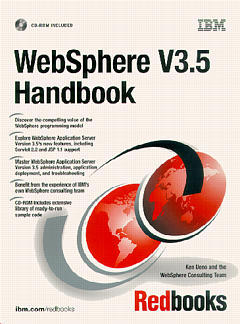WebSphere V3.5 handbook with CD-ROM
Langue : Anglais
Auteur : UENO

WebSphere V3.5 Handbook: Using WebSphere Application Server Standard and Advanced Editions
IBM Books
Ken Ueno
The only authoritative, start-to-finish resource guide for WebSphere Application Server V3 5.
1. Overview of WebSphere Application Server V3.
2. Whats new in WebSphere V3.5?
3. WebSphere programming model.
4. WebSphere components.
5. Servlet support.
6. JSP support.
7. Session support.
8. Servlet V2.2 in WebSphere V3.5.2.
9. Using JNDI to access LDAP.
10. JDBC 2.0 support.
11. Enterprise Java Services.
12. Transactions.
13. XML and WebSphere.
14. Application deployment.
15. WebSphere security.
16. Topologies selection.
What is WebSphere Application Server? WebSphere Application Server architecture overview. Standard Edition. Advanced Edition. Open standards.
2. Whats new in WebSphere V3.5?
Installation. InfoCenter. Migration. Java 2 support. Security. New and improved administration tools. New and improved connection pooling. New Resource Analyzer. New Log Analyzer. New platform support. New database support. New Web Server support. Conclusion.
3. WebSphere programming model.
Analysis of an example application. Application components. Control flow mechanisms. Data flow sources. Chapter summary.
4. WebSphere components.
WebSphere Administrative Server. Application server. What is an enterprise application? WebSphere administrative interfaces.
5. Servlet support.
What is a servlet? How servlets work. WebSphere and servlets. Writing a simple servlet example. Deploying the example servlet under WebSphere. Internal servlets.
6. JSP support.
Using JSP to present dynamic content. The collaboration between form, servlet, and JSP. Rapid development using JSP. JSP life cycle. Administering JSP files. Batch compiling JSP files. JSP. Configuring and running your JSPs. Custom tag examples.
7. Session support.
V3.02.x vs. V3.5 overview. Session feature overview. Session Performance considerations. Alternatives to session support: cookies.
8. Servlet V2.2 in WebSphere V3.5.2.
WebSphere support for Servlet API V2.2. Selecting Servlet V2.2 support. Comparison of the Servlet API versions. Multiple error pages. Welcome file lists. The Web Application Archive (WAR). Deploying an application from a WAR file.
9. Using JNDI to access LDAP.
What is JNDI? Naming concepts. JNDI specifications. JNDI sample application.
10. JDBC 2.0 support.
JDBC 2.0 Core API. JDBC 2.0 Optional Extension API. Administration of data sources. Best practices for JDBC 2.0 data access with WebSphere. Recovery from DB failures. Reference information.
11. Enterprise Java Services.
Configuring Enterprise Java Services. Installing an EJB into a container. Stateless session beans. Stateful session beans. Container managed persistence (CMP) entity beans. WebSphere EJB security.
12. Transactions.
Transaction basics. Java and transactions. Enterprise JavaBeans distributed transaction support. EJB concurrency control. Settings based on EJB usage. Transaction exception handling. WebSphere family interoperability. Conclusion.
13. XML and WebSphere.
XML overview. Using XML in WebSphere. An XML example. XML basics. XML and Web browsers: XSL and CSS. Programming with XML. Summary.
14. Application deployment.
Samples we used. Before configuration. Create a virtual host. Create a JDBC driver and data source. Create an application server and other basic resources. Placing source files. Add Servlet. Create enterprise beans. Verification of the servlet and EJB. Create an enterprise application. Verification of an enterprise application. Deployment and classpaths.
15. WebSphere security.
Application security. WebSphere security model. Whats new in WebSphere V3.5 security. Using client certificate based authentication with WebSphere. WebSphere and LDAP servers. Custom challenge.
16. Topologies selection.
Topology selection criteria. Vertical scaling with WebSphere workload management. HTTP server separation from the application server. Scaling WebSphere in a three-tier environment. Horizontally scaling Web servers with WebSphere. One WebSphere domain vs. many. Multiple applications within one node vs. one application per node. Closing thoughts on topolog
Date de parution : 05-2001
Ouvrage de 1154 p.
18x23 cm
Thème de WebSphere V3.5 handbook with CD-ROM :
© 2024 LAVOISIER S.A.S.
